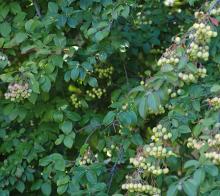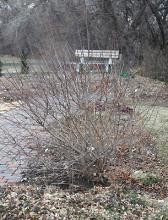Viburnum prunifolium
Common name:
Blackhaw Viburnum
Pronunciation:
vi-BER-num pru-ni-FO-li-um
Family:
Adoxaceae, Caprifoliaceae
Genus:
Type:
Broadleaf
Native to (or naturalized in) Oregon:
No
- Deciduous shrub or small tree, 12-15 ft (3.5-4.5 m) tall, somewhat less in width, stiffly branched. Leaves opposite, simple, variable shape, broad-elliptic, ovate, obovate, and rounded, 4-9 cm long, 2.5-5 cm wide, tip acute or obtuse, rounded at base or broad wedge-shaped, margin serrate, dull to glossy green above, pale below, red fall color; petiole reddish, 8-18 mm long. Flowers small, creamy, in flat-topped clusters, 5-10 cm wide. Fruit oval, to 13 mm long, pinkish, finally blue-black, bloomy, at maturity, edible, used for preserves since colonial times.
- Sun. Will tolerate poor soils and drought. Somewhat coarse textured, can be sheared to a hedge or grown as a small tree and sometimes recommended as a substitute for hawthorn.
- Hardy to USDA Zone 3 Native range from Connecticut to Florida, west to Michigan and Texas.
- May be confused with Viburnum rufidulum [Rusty Blackhaw Viburnum]. Stephens (1973, p. 282) offers these characteristics to separate them: in summer V. rufidulum has red-rufescent tomentum (red tinged pubescence) on the petioles, broadly winged petioles and leathery leaf blades whereas V. prunifolium lack these characteristics. In winter the buds of V. rufidulum are dark red brown and those of V. prunifolium are a definite gray-pink.








